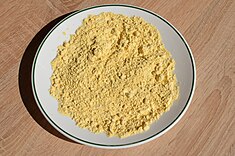Chickpea flour
 |
|
| Nutritional value per 100 g (3.5 oz) | |
|---|---|
| Energy | 1,619 kJ (387 kcal) |
|
57 g
|
|
| Sugars | 10 g |
| Dietary fiber | 10 g |
|
6 g
|
|
|
22 g
|
|
| Vitamins | |
| Niacin (B3) |
(7%)
1 mg |
| Folate (B9) |
(109%)
437 μg |
| Minerals | |
| Calcium |
(5%)
45 mg |
| Iron |
(31%)
4 mg |
| Magnesium |
(47%)
166 mg |
| Phosphorus |
(45%)
318 mg |
| Potassium |
(18%)
846 mg |
| Sodium |
(4%)
64 mg |
| Zinc |
(21%)
2 mg |
| Other constituents | |
| Water | 10 g |
|
|
| Percentages are roughly approximated using US recommendations for adults. Source: USDA Nutrient Database |
|
Gram flour or besan (Hindi: बेसन; Burmese: ပဲမှုန့်; Urdu: بيسن), is a pulse flour made from a variety of ground chickpea known as Bengal gram. It is a staple ingredient in the cuisine of the Indian subcontinent, including in Indian, Bangladeshi, Burmese, Nepali, Pakistani and Sri Lankan cuisines. Gram flour can be made from either raw or roasted gram beans. The roasted variety is more flavorful, while the raw variety has a slightly bitter taste.
In the form of a paste with water or yogurt, it is also popular as a facial exfoliant in the Indian Subcontinent. When mixed with an equal proportion of water, it can be used as an egg replacement in vegan cooking.
Gram flour contains a high proportion of carbohydrates, no gluten, and a higher proportion of protein than other flours.
Gram flour is most popular in the cuisine of the Indian subcontinent, where it is used to make the following:
In Andhra Pradesh, it is used in a curry with gram flour cakes called Senaga Pindi Kura (Telugu: శెనగ పిండి కూర) and is eaten with Chapati or Puri, mostly during winter for breakfast. Chila (or chilla), a pancake made with gram flour batter, is a popular street food in India.
...
Wikipedia
